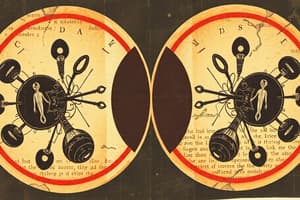Podcast
Questions and Answers
What is the primary function of mitosis?
What is the primary function of mitosis?
- To enable cell growth, repair and asexual reproduction (correct)
- To reduce the number of chromosomes by half
- To produce gametes for sexual reproduction
- To create genetic diversity through recombination
How many daughter cells are produced at the end of mitosis from a single parent cell?
How many daughter cells are produced at the end of mitosis from a single parent cell?
- Four
- Two (correct)
- Six
- One
If a cell undergoing mitosis starts with a diploid number of chromosomes, what is the chromosomal state of the daughter cell?
If a cell undergoing mitosis starts with a diploid number of chromosomes, what is the chromosomal state of the daughter cell?
- Tetraploid
- Triploid
- Diploid (correct)
- Haploid
During which phase of mitosis do sister chromatids separate and move towards opposite poles?
During which phase of mitosis do sister chromatids separate and move towards opposite poles?
What is the key difference between mitosis and meiosis in terms of chromosome number?
What is the key difference between mitosis and meiosis in terms of chromosome number?
What is the term given to the structure formed when homologous pairs come together during Prophase I of meiosis?
What is the term given to the structure formed when homologous pairs come together during Prophase I of meiosis?
Which process during meiosis results in the exchange of genetic material between homologous chromosomes?
Which process during meiosis results in the exchange of genetic material between homologous chromosomes?
Which type of mutation is most likely to be eliminated within a few generations?
Which type of mutation is most likely to be eliminated within a few generations?
Where are neutral mutations MOST likely to occur?
Where are neutral mutations MOST likely to occur?
What is the primary effect of a beneficial mutation?
What is the primary effect of a beneficial mutation?
The effect of a mutation is LEAST likely to be influenced by which factor?
The effect of a mutation is LEAST likely to be influenced by which factor?
In a region with malaria, why is the S allele beneficial as a heterozygous genotype?
In a region with malaria, why is the S allele beneficial as a heterozygous genotype?
What is the practice of interbreeding between two different varieties or species of an organism called?
What is the practice of interbreeding between two different varieties or species of an organism called?
Which of the following was NOT a physical feature studied by Mendel in pea plants?
Which of the following was NOT a physical feature studied by Mendel in pea plants?
What is meant by 'true breeding' in the context of genetics?
What is meant by 'true breeding' in the context of genetics?
What is the primary process responsible for the creation of new genes?
What is the primary process responsible for the creation of new genes?
What term describes the slow accumulation of different mutations in duplicated copies of a gene over time?
What term describes the slow accumulation of different mutations in duplicated copies of a gene over time?
What is a group of genes with related functions, usually resulting from multiple rounds of duplication and divergence called?
What is a group of genes with related functions, usually resulting from multiple rounds of duplication and divergence called?
What are the differences among individuals in the number of copies of a region of the genome known as?
What are the differences among individuals in the number of copies of a region of the genome known as?
Which of the following describes a region along a DNA molecule where many identical copies of a short sequence of nucleotides are adjacent to one another?
Which of the following describes a region along a DNA molecule where many identical copies of a short sequence of nucleotides are adjacent to one another?
What is the term for the analysis of a small quantity of DNA to uniquely identify an individual?
What is the term for the analysis of a small quantity of DNA to uniquely identify an individual?
What type of chromosomal change involves reversing the normal order of a block of genes?
What type of chromosomal change involves reversing the normal order of a block of genes?
What is the exchange of parts between nonhomologous chromosomes known as?
What is the exchange of parts between nonhomologous chromosomes known as?
If environmental effects are not transmitted across generations, what will the mean phenotype of the offspring be?
If environmental effects are not transmitted across generations, what will the mean phenotype of the offspring be?
What does the slope of the regression line in Galton's data, equalling 0.60, indicate about variation in height?
What does the slope of the regression line in Galton's data, equalling 0.60, indicate about variation in height?
What is cultural transmission?
What is cultural transmission?
Averagely, why might the offspring of wealthy parents have more wealth than offspring of poorer parents?
Averagely, why might the offspring of wealthy parents have more wealth than offspring of poorer parents?
What does heritability measure?
What does heritability measure?
If a trait has a heritability of 100%, what does that mean?
If a trait has a heritability of 100%, what does that mean?
When does heritability apply to a study?
When does heritability apply to a study?
How does heritability impact artificial selection?
How does heritability impact artificial selection?
What does a high heritability of a trait indicate about its response to selection?
What does a high heritability of a trait indicate about its response to selection?
The phenomenon where a single gene influences multiple seemingly unrelated traits is known as:
The phenomenon where a single gene influences multiple seemingly unrelated traits is known as:
What is the term for the phenomenon when multiple genes act in the same pathway to affect a trait?
What is the term for the phenomenon when multiple genes act in the same pathway to affect a trait?
How do most genes contribute to complex traits?
How do most genes contribute to complex traits?
What factors might explain differences in complex traits between males and females?
What factors might explain differences in complex traits between males and females?
What was the result of the analysis of human height looking at genes affecting it?
What was the result of the analysis of human height looking at genes affecting it?
The identification of genes influencing a complex condition such as cholesterol levels may be shown:
The identification of genes influencing a complex condition such as cholesterol levels may be shown:
How do findings about the genetics of complex traits potentially contribute to personalized medicine?
How do findings about the genetics of complex traits potentially contribute to personalized medicine?
What is the primary effect of the formation of chiasmata during meiosis?
What is the primary effect of the formation of chiasmata during meiosis?
During which phase of meiosis do bivalents align at the center of the cell?
During which phase of meiosis do bivalents align at the center of the cell?
What is a key feature of anaphase I that distinguishes it from anaphase II?
What is a key feature of anaphase I that distinguishes it from anaphase II?
What is the state of chromosomes at the end of Telophase I?
What is the state of chromosomes at the end of Telophase I?
What happens to the centromeres during Anaphase II?
What happens to the centromeres during Anaphase II?
How does the alignment of bivalents during metaphase I contribute to genetic diversity?
How does the alignment of bivalents during metaphase I contribute to genetic diversity?
What is the chromosome number in the nuclei at the start of prophase II, compared to the parent cell?
What is the chromosome number in the nuclei at the start of prophase II, compared to the parent cell?
During which stage of meiosis do spindle microtubules attach to kinetochores?
During which stage of meiosis do spindle microtubules attach to kinetochores?
Flashcards
Mitosis
Mitosis
A type of cell division where a parent cell divides into two identical daughter cells.
Prophase
Prophase
The stage of mitosis where the chromosomes condense and become visible, the nuclear membrane breaks down, and the spindle fibers start to form.
Metaphase
Metaphase
The stage of mitosis where the chromosomes line up in the middle of the cell, attached to the spindle fibers.
Anaphase
Anaphase
Signup and view all the flashcards
Telophase
Telophase
Signup and view all the flashcards
Meiosis
Meiosis
Signup and view all the flashcards
Prophase I
Prophase I
Signup and view all the flashcards
Metaphase I
Metaphase I
Signup and view all the flashcards
Duplication and Divergence
Duplication and Divergence
Signup and view all the flashcards
Gene Family
Gene Family
Signup and view all the flashcards
Copy-Number Variations (CNVs)
Copy-Number Variations (CNVs)
Signup and view all the flashcards
Tandem Repeats
Tandem Repeats
Signup and view all the flashcards
DNA Typing
DNA Typing
Signup and view all the flashcards
Inversion
Inversion
Signup and view all the flashcards
Reciprocal Translocation
Reciprocal Translocation
Signup and view all the flashcards
Gene Dosage
Gene Dosage
Signup and view all the flashcards
Crossing Over
Crossing Over
Signup and view all the flashcards
Chiasmata
Chiasmata
Signup and view all the flashcards
Independent Assortment
Independent Assortment
Signup and view all the flashcards
Meiosis II
Meiosis II
Signup and view all the flashcards
Mutation
Mutation
Signup and view all the flashcards
Harmful Mutation
Harmful Mutation
Signup and view all the flashcards
Neutral Mutation
Neutral Mutation
Signup and view all the flashcards
Beneficial Mutation
Beneficial Mutation
Signup and view all the flashcards
Effect of Mutation on Genotype
Effect of Mutation on Genotype
Signup and view all the flashcards
Effect of Mutation on Environment
Effect of Mutation on Environment
Signup and view all the flashcards
Hybridization
Hybridization
Signup and view all the flashcards
True Breeding
True Breeding
Signup and view all the flashcards
Cultural Transmission
Cultural Transmission
Signup and view all the flashcards
Heritability
Heritability
Signup and view all the flashcards
Heritability of 100%
Heritability of 100%
Signup and view all the flashcards
Heritability of 0%
Heritability of 0%
Signup and view all the flashcards
Heritability's Scope
Heritability's Scope
Signup and view all the flashcards
Artificial Selection
Artificial Selection
Signup and view all the flashcards
Heritability in Selection
Heritability in Selection
Signup and view all the flashcards
Offspring Phenotype
Offspring Phenotype
Signup and view all the flashcards
Heritability and Selection Response
Heritability and Selection Response
Signup and view all the flashcards
Complex Traits are Polygenic
Complex Traits are Polygenic
Signup and view all the flashcards
Pleiotropy
Pleiotropy
Signup and view all the flashcards
Epistasis in Complex Traits
Epistasis in Complex Traits
Signup and view all the flashcards
Small Effect Size in Polygenic Traits
Small Effect Size in Polygenic Traits
Signup and view all the flashcards
Genetic Complexity of Human Height
Genetic Complexity of Human Height
Signup and view all the flashcards
Personalized Medicine
Personalized Medicine
Signup and view all the flashcards
Study Notes
Mitosis (IPMAT)
- Cellular replication without chromosomal reduction
- One parent cell divides to produce two daughter cells
- If the parent cell is diploid, the daughter cells will also be diploid
- Mitosis is how multicellular organisms grow and repair themselves
IPMAT Stages
- Interphase: The cell prepares for division by replicating its DNA and increasing in size.
- Prophase: Chromosomes become visible, the nuclear membrane breaks down, and spindle fibers start to form.
- Metaphase: Chromosomes align along the cell's equator, attached to spindle fibers.
- Anaphase: Sister chromatids of each chromosome separate and move to opposite cell poles.
- Telophase: New nuclear membranes form around the separated chromosomes, creating two new nuclei; cytokinesis (splitting into daughter cells) follows.
Meiosis
- Cellular replication with chromosomal reduction
- One parent cell produces four daughter cells
- The daughter cells are haploid (have half the number of chromosomes as the parent cell)
- Meiosis is involved in the production of gametes (sex cells)
Meiosis I
- Prophase I: Chromosomes condense, homologous chromosomes pair (forming tetrads), and crossing over occurs.
- Metaphase I: Homologous chromosome pairs align at the metaphase plate.
- Anaphase I: Homologous chromosomes separate and move to opposite poles.
- Telophase I: New nuclear membranes form around the separated chromosomes, cytokinesis divides the cell into two haploid cells.
Meiosis II
- Prophase II: Chromosomes condense, nuclear membranes break down, and spindle fibers form.
- Metaphase II: Chromosomes align at the metaphase plate.
- Anaphase II: Sister chromatids separate and move to opposite poles.
- Telophase II: New nuclear membranes form around the separated chromosomes, cytokinesis divides each cell into two, resulting in four haploid daughter cells.
Mitosis vs. Meiosis
- Mitosis produces two identical daughter cells; meiosis produces four genetically unique daughter cells
- Mitosis maintains the chromosome number, whereas meiosis reduces the chromosome number by half.
Studying That Suits You
Use AI to generate personalized quizzes and flashcards to suit your learning preferences.





